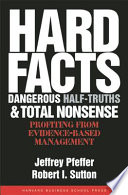

The book emphasizes the necessity of relying on hard data when making decisions in business. It argues that many leaders often fall prey to anecdotal evidence and personal biases, which can lead to poor decision-making. By grounding decisions in empirical data, organizations can mitigate risks and enhance their strategic planning. The authors provide various case studies illustrating how companies that prioritize data have outperformed those that rely on intuition or incomplete information. They also discuss the challenges of data interpretation, urging leaders to cultivate a culture that values evidence over opinion.
Continue readingOverconfidence is a recurring theme in the book, highlighting how it can skew judgment and lead to catastrophic business decisions. The authors argue that leaders often overestimate their abilities and the accuracy of their forecasts, which can result in significant failures. They present psychological studies that demonstrate how overconfidence can distort risk perception and lead to reckless behavior. The book encourages leaders to adopt a more humble approach, seeking out diverse perspectives and being open to feedback to counteract the effects of overconfidence.
Continue readingCritical thinking is presented as a vital skill for leaders and organizations. The authors argue that the ability to analyze information, question assumptions, and evaluate evidence is essential for effective decision-making. They provide tools and frameworks for fostering critical thinking within teams, emphasizing the importance of creating an environment where questioning and healthy debate are encouraged. By cultivating critical thinking, organizations can avoid the pitfalls of groupthink and develop more robust strategies.
Continue readingIn today's fast-paced business environment, uncertainty and complexity are the norm. The book discusses strategies for navigating these challenges, advocating for flexible and adaptive leadership. The authors highlight the importance of scenario planning and risk assessment, urging leaders to prepare for multiple outcomes rather than relying on a single forecast. They also discuss the value of agility in decision-making, encouraging organizations to pivot quickly in response to new information or changing circumstances.
Continue readingCollaboration is framed as a key driver of innovation and success in organizations. The authors argue that cross-functional teams can lead to more creative solutions and better decision-making. They provide examples of companies that have successfully implemented collaborative practices and the benefits they have reaped. The book emphasizes the need for leaders to break down silos and foster an environment where diverse teams can thrive. Additionally, it discusses the role of technology in facilitating collaboration, highlighting tools that can enhance communication and teamwork.
Continue readingOrganizational culture is explored as a crucial factor influencing decision-making and performance. The authors argue that a strong culture aligned with the company's values can drive success, while a toxic culture can lead to dysfunction and failure. They provide insights into how leaders can shape and nurture a positive culture, emphasizing the importance of transparency, trust, and accountability. The book also discusses the role of storytelling in reinforcing culture and aligning teams around a shared vision.
Continue readingThe final key idea revolves around the necessity of continuous learning in an ever-changing business landscape. The authors advocate for a growth mindset, encouraging leaders and organizations to embrace new ideas and adapt to change. They discuss the importance of ongoing education, training, and professional development, highlighting how organizations that prioritize learning are better equipped to innovate and compete. The book also touches on the role of failure as a learning opportunity, urging leaders to view setbacks as chances for growth rather than as defeats.
Continue reading